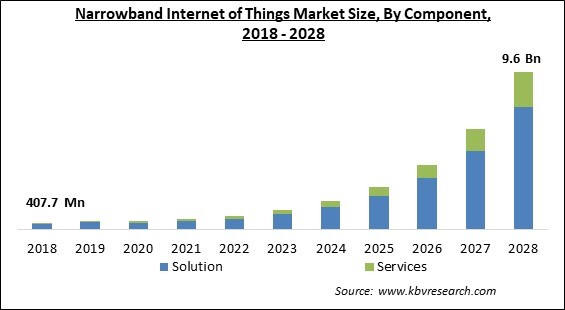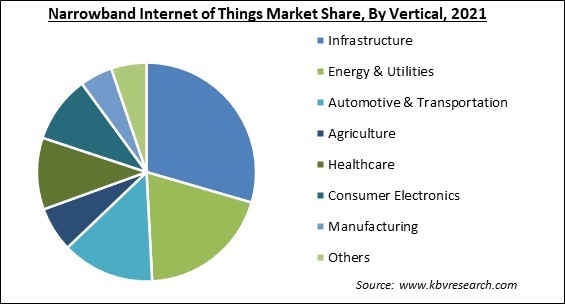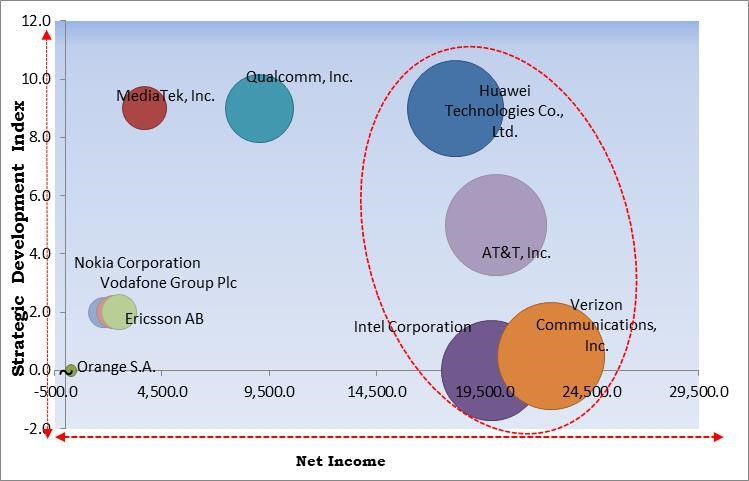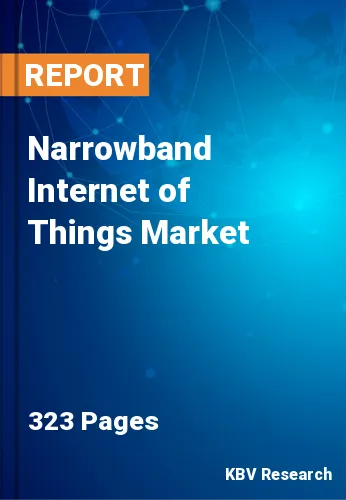The Global Narrowband Internet of Things Market size is expected to reach $9.6 billion by 2028, rising at a market growth of 51.5% CAGR during the forecast period.
Narrowband IoT refers to a LPWA (low power wide space) technology that was designed to transform a good range of latest IoT services and devices. The technology dependably and firmly manages less amount of relatively seldom two-way knowledge. Narrowband IoT remarkably betters operators’ device spectrum potency, system capability, and power consumption. The technology enables various devices and solutions such as utilities, wearables, good parking, and industrial solutions.

In general, LPWA technologies bridges the gap between mobiles, such as 3G and LTE, and short-range wireless, such as ZigBee networks, Wi-Fi, and Bluetooth. Narrowband IoT is supported by all major module makers, mobile instrumentality, and chipsets. NB-IoT would co-exist with 4G, 3G, and 2G mobile networks and collaborative profits from the privacy and safety choices of mobile networks, such as entity authentication, support for user identity confidentiality, knowledge integrity, confidentiality, and mobile instrumentality identification.
The application of narrowband IoT leads to various benefits such as price savings, power potency, wider preparation, and dependability. Narrowband IoT allows the cost-effective powering of IoT devices. Because technologies such as NB-IoT have a few complex waveforms, they tend to use less power. NB-IoT chips are cheaper as they are less complex to make. Narrowband IoT application also leads to enhanced dependability for operators because of the bonded resource allotment needed for controlled quality of service.
NB-IoT is set to directly connect the narrowband IoT usage and might be perceived as extra wide-enforced with the growing urbanization worldwide. NB-IoT devices are employed within the commissioned spectrum and ensure reliable and secure property to consumers.
Major corporations have evolved towards use of automation technologies as a result of the COVID-19 pandemic, particularly in the area of drones for monitoring and drug delivery. Robotics and automation could boost productivity in a circumstances created by pandemic by reducing the need for human labour and decreasing the likelihood of future plant closures. IoT, AI, and digitalization will also become increasingly important in the future and define the new way of working. Owing to all these factors, the market for narrowband internet of things has significantly benefited from the spread of novel coronavirus and also will witness growth prospects after the pandemic period.
Battery life is a significant feature in the current scenario of IoT devices and various connected devices. Smartphone manufacturers are constantly attempting to enhance devices with massive battery life as the latest smartphones are so distinct from their previous versions that were available a few years back. Additionally, technologies are developing and turning out to be more sophisticated and advanced every year. As a result, the market demand for connected devices is growing, especially in the industrial sector, as M2M communications got more frequent. The growth of M2M or IoT devices involving livestock monitoring equipment, smart meters, smart parking solutions, and smart streetlights is expected to be propelled by the rising necessity for connected devices for long-range connectivity.
Businesses will not make remarkable investments in the latsest technology if it doesn’t expand their bottom line for prolonged period. With the quickly growing information infrastructure and the economy being so interconnected, this consideration has become more appropriate than before. NB-IoT and other technologies utilize a very simple waveform, which operates on low power. Nevertheless, it is not just about saving power. As NB-IoT is gaining more popularity, creating NB-IoT devices would become cheaper. This would provide with a positive feedback cycle that would further benefit both customers and companies. These factors are predicted to increase the adoption of narrowband internet of things, thereby supporting the market expansion.
Data transfer speeds are restricted in NB-IoT devices, which limits their cellular abilities in apps that demand remarkable bandwidth, like video surveillance and voice communication. It is unsuitable for mobile handsets utilizing GSM, high-speed data transmission, messaging, 3G, and LTE (long-term evolution) for voice. Emerging technologies like LTE-M (long-term evolution for machines) have quicker data speeds, which enables them to offer the most inclusive scale of cellular capabilities. LTE-M has the highest bandwidth compared to other LPWA technologies, making it accurate for mobile networks and stationary usage. Therefore, this obstructs the growth of the narrowband internet of things market in the upcoming years.
Based on components, the narrowband internet of things market is segmented into solutions and services. In 2021, the service segment garnered a significant revenue share in the narrowband internet of things. This is due to decreased power consumption of linked devices while expanding bandwidth efficiency and system capacity. In addition, the market is expanding in this segment due to the increased adoption of internet of things (IoT) in various industry verticals.

By application, the narrowband internet of things market is divided into smart meter, smart packaging, alarm & detector, smart lightning, tracker, wearable and others. In 2021, the tracker segment recorded a prominent revenue share in the narrowband internet of things market. This is because of the expanding consumer and industrial usage comprising monitoring & tracking of people and assets. In addition, the growing demand for navigation, telematics, and in-car infotainment facilities from the automotive sector is expected to contribute to the development of the tracker segment throughout the predicted period.
On the basis of deployment, the narrowband internet of things market is fragmented into in-band, guard band, and standalone. In 2021, the standalone segment registered a substantial revenue share in the narrowband internet of things. In the standalone category, workers use NB-IoT to take advantage of idle spectrum resources. These resources may consist of the employee's non-standard bandwidth spectrum pieces or be exempt from other RATs (radio access technologies) through refarming.
Based on vertical, the narrowband internet of things market is classified into infrastructure, agriculture, automotive, healthcare, energy & utilities, manufacturing, consumer electronics and others. In 2021, the automotive segment procured a considerable growth rate in the narrowband internet of things market. The automotive companies are trying to overcome the safety related issues faced by passengers by using advanced technologies that could provide more convenient and safer transportation. As such, the implementation of narrowband-IoT in the automotive industry is rapidly growing because of the ability of NB-IoT to avoid and determine main road congestions, track vehicles, and contribute in efficient traffic control.
| Report Attribute | Details |
|---|---|
| Market size value in 2021 | USD 605.5 Million |
| Market size forecast in 2028 | USD 9.6 Billion |
| Base Year | 2021 |
| Historical Period | 2018 to 2020 |
| Forecast Period | 2022 to 2028 |
| Revenue Growth Rate | CAGR of 51.5% from 2022 to 2028 |
| Number of Pages | 323 |
| Number of Tables | 522 |
| Report coverage | Market Trends, Revenue Estimation and Forecast, Segmentation Analysis, Regional and Country Breakdown, Competitive Landscape, Companies Strategic Developments, Company Profiling |
| Segments covered | Component, Application, Deployment Mode, Vertical, Region |
| Country scope | US, Canada, Mexico, Germany, UK, France, Russia, Spain, Italy, China, Japan, India, South Korea, Singapore, Malaysia, Brazil, Argentina, UAE, Saudi Arabia, South Africa, Nigeria |
| Growth Drivers |
|
| Restraints |
|
Region-wise, the narrowband internet of things market, is analysed across North America, Europe, Asia Pacific and LAMEA. In 2021, the North America region dominated the narrowband internet of things market with the maximum revenue share. North America is the hub of various dominating device producer businesses and network service suppliers concentrating on examining & commercializing solutions for industrial and consumer applications. The growing tech-savvy population, increasing disposable income, and continuous acceptance of developing technologies for business and personal applications are some of the prime factors propelling the regional market development.
Free Valuable Insights: Global Narrowband Internet of Things Market size to reach USD 9.6 Billion by 2028

The major strategies followed by the market participants are Partnerships. Based on the Analysis presented in the Cardinal matrix; Huawei Technologies Co., Ltd., AT&T, Inc., Intel Corporation, Verizon Communications, Inc. are the forerunners in the Narrowband Internet of Things Market. Companies such as Qualcomm, Inc., MediaTek, Inc., and Ericsson AB are some of the key innovators in Narrowband Internet of Things Market.
The market research report covers the analysis of key stake holders of the market. Key companies profiled in the report include Intel Corporation, Qualcomm, Inc., Huawei Technologies Co., Ltd. MediaTek, Inc., Nokia Corporation, Verizon Communications, Inc., AT&T, Inc., Vodafone Group Plc, Orange S.A., and Ericsson AB.
By Component
By Application
By Deployment Mode
By Vertical
By Geography
The global Narrowband Internet of Things Market size is expected to reach $9.6 billion by 2028.
Growing adoption of IoT technologies and better battery life of other connected devices are driving the market in coming years, however, Restricted To Low-Speed Data Transmission Applications restraints the growth of the market.
Intel Corporation, Qualcomm, Inc., Huawei Technologies Co., Ltd. MediaTek, Inc., Nokia Corporation, Verizon Communications, Inc., AT&T, Inc., Vodafone Group Plc, Orange S.A., and Ericsson AB.
The Solution market acquired the maximum revenue share in the Global Narrowband Internet of Things Market by Component in 2021, and would continue to be a dominant market till 2028; thereby, achieving a market value of $7.4 Billion by 2028.
The Guard market is leading the Global Narrowband Internet of Things Market by Deployment Mode in 2021, and would continue to be a dominant market till 2028; thereby, achieving a market value of $4.3 Billion by 2028.
The North America market dominated the Global Narrowband Internet of Things Market by Region in 2021, and would continue to be a dominant market till 2028; thereby, achieving a market value of $3.2 Billion by 2028.
Our team of dedicated experts can provide you with attractive expansion opportunities for your business.

